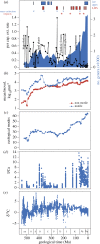The evolution of complex life and the stabilization of the Earth system
- PMID: 32642051
- PMCID: PMC7333899
- DOI: 10.1098/rsfs.2019.0106
The evolution of complex life and the stabilization of the Earth system
Abstract
The half-billion-year history of animal evolution is characterized by decreasing rates of background extinction. Earth's increasing habitability for animals could result from several processes: (i) a decrease in the intensity of interactions among species that lead to extinctions; (ii) a decrease in the prevalence or intensity of geological triggers such as flood basalt eruptions and bolide impacts; (iii) a decrease in the sensitivity of animals to environmental disturbance; or (iv) an increase in the strength of stabilizing feedbacks within the climate system and biogeochemical cycles. There is no evidence that the prevalence or intensity of interactions among species or geological extinction triggers have decreased over time. There is, however, evidence from palaeontology, geochemistry and comparative physiology that animals have become more resilient to an environmental change and that the evolution of complex life has, on the whole, strengthened stabilizing feedbacks in the climate system. The differential success of certain phyla and classes appears to result, at least in part, from the anatomical solutions to the evolution of macroscopic size that were arrived at largely during Ediacaran and Cambrian time. Larger-bodied animals, enabled by increased anatomical complexity, were increasingly able to mix the marine sediment and water columns, thus promoting stability in biogeochemical cycles. In addition, body plans that also facilitated ecological differentiation have tended to be associated with lower rates of extinction. In this sense, Cambrian solutions to Cambrian problems have had a lasting impact on the trajectory of complex life and, in turn, fundamental properties of the Earth system.
Keywords: animals; biodiversity; evolution.
© 2020 The Author(s).
Conflict of interest statement
We declare we have no competing interests.
Figures



References
Publication types
LinkOut - more resources
Full Text Sources
